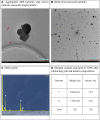Assessment and Mitigation of Exposure of 3-D Printer Emissions
- PMID: 35295129
- PMCID: PMC8915804
- DOI: 10.3389/ftox.2021.817454
Assessment and Mitigation of Exposure of 3-D Printer Emissions
Abstract
This study monitored particulates, and volatile organic compounds (VOCs) emitted from 3-D printers using acrylonitrile-butadiene-styrene copolymer (ABS) filaments at a workplace to assess exposure before and after introducing exposure mitigation measures. Air samples were collected in the printing room and adjacent corridor, and real-time measurements of ultrafine and fine particle were also conducted. Extensive physicochemical characterizations of 3-D printer emissions were performed, including real-time (size distribution, number concentration) nanoparticle characterization, size-fractionated mass distribution and concentration, as well as chemical composition for metals by ICP-MS and VOCs by GC-FID, real-time VOC monitors, and proton-transfer-reaction time-of-flight mass spectrometer (PTR-TOF-MS). Air sampling showed low levels of total suspended particulates (TSP, 9-12.5/m3), minimal levels (1.93-4 ppm) of total volatile organic chemicals (TVOC), and formaldehyde (2.5-21.7 ppb). Various harmful gases, such as formaldehyde, acrolein, acetone, hexane, styrene, toluene, and trimethylamine, were detected at concentrations in the 1-100 ppb by PTR-TOF-MS when air sample was collected into the Tedlar bag from the front of the 3-D printer. Ultrafine particles having an average particle size (30 nm count median diameter and 71 nm mass median diameter) increased during the 3-D printing operation. They decreased to the background level after the 3-D printing operation, while fine particles continually increased after the termination of 3-D printing to the next day morning. The exposure to 3-D printer emissions was greatly reduced after isolating 3-D printers in the enclosed space. Particle number concentration measured by real-time particle counters (DMAS and OPC) were greatly reduced after isolating 3-D printers to the isolated place.
Keywords: 3-D printer; emission; exposure assessment; mitigation; particles; volatile organic chemicals (VOCs).
Copyright © 2022 Kim, Shin, Kim, Jo, Kim, Lee, Lee, Kwon, Han, Kang, Gulumian, Bello and Yu.
Conflict of interest statement
Authors HoK, MJ, HeK, HL, and IY were employed by HCTm and IY is employed by HCT, Co. The remaining authors declare that the research was conducted in the absence of any commercial or financial relationships that could be construed as a potential conflict of interest.
Figures




References
-
- Afshar-Mohajer N., Wu C.-Y., Ladun T., Rajon D. A., Huang Y. (2015). Characterization of Particulate Matters and Total VOC Emissions from a Binder Jetting 3D Printer. Building Environ. 93, 293–301. 10.1016/j.buildenv.2015.07.013 - DOI
-
- Deng Y., Cao S.-J., Chen A., Guo Y. (2016). The Impact of Manufacturing Parameters on Submicron Particle Emissions from a Desktop 3D Printer in the Perspective of Emission Reduction. Building Environ. 104, 311–319. 10.1016/j.buildenv.2016.05.021 - DOI
-
- Farcas M. T., Stefaniak A. B., Knepp A. K., Bowers L., Mandler W. K., Kashon M., et al. (2019). Acrylonitrile Butadiene Styrene (ABS) and Polycarbonate (PC) Filaments Three-Dimensional (3-D) Printer Emissions-Induced Cell Toxicity. Toxicol. Lett. 317, 1–12. 10.1016/j.toxlet.2019.09.013 - DOI - PMC - PubMed
LinkOut - more resources
Full Text Sources
Miscellaneous

